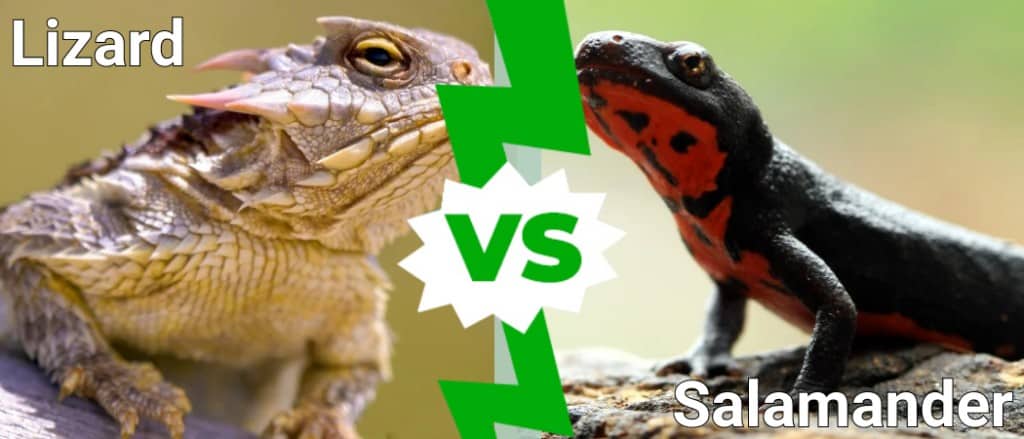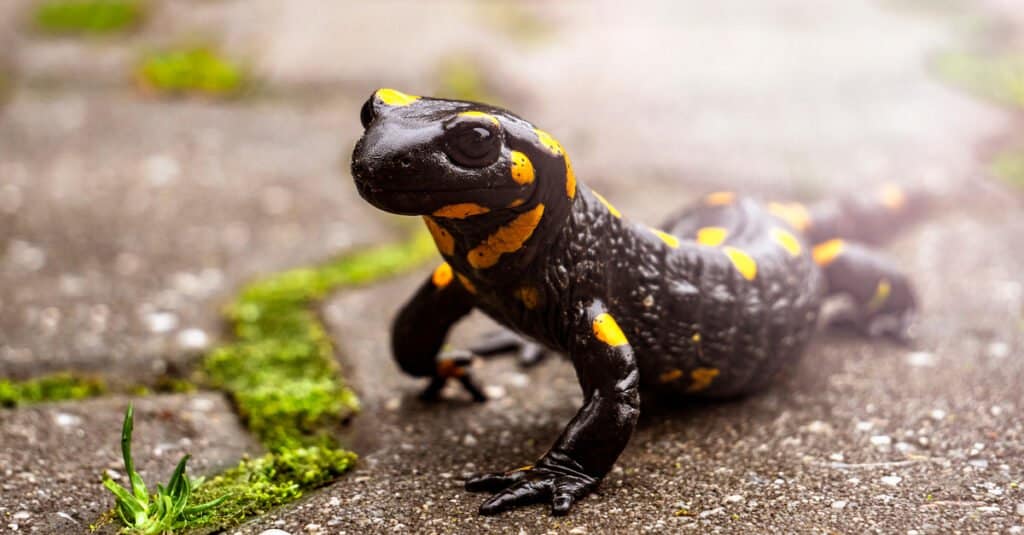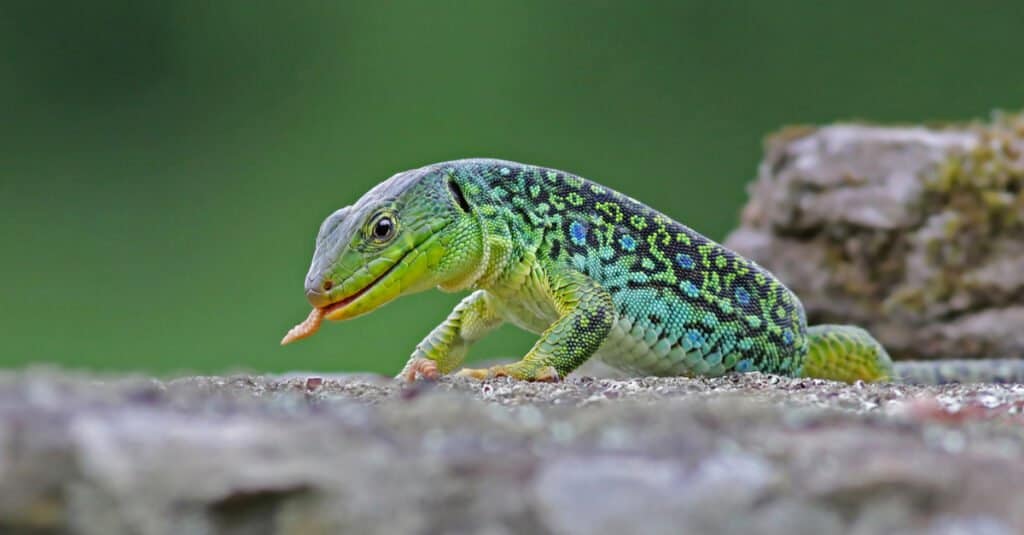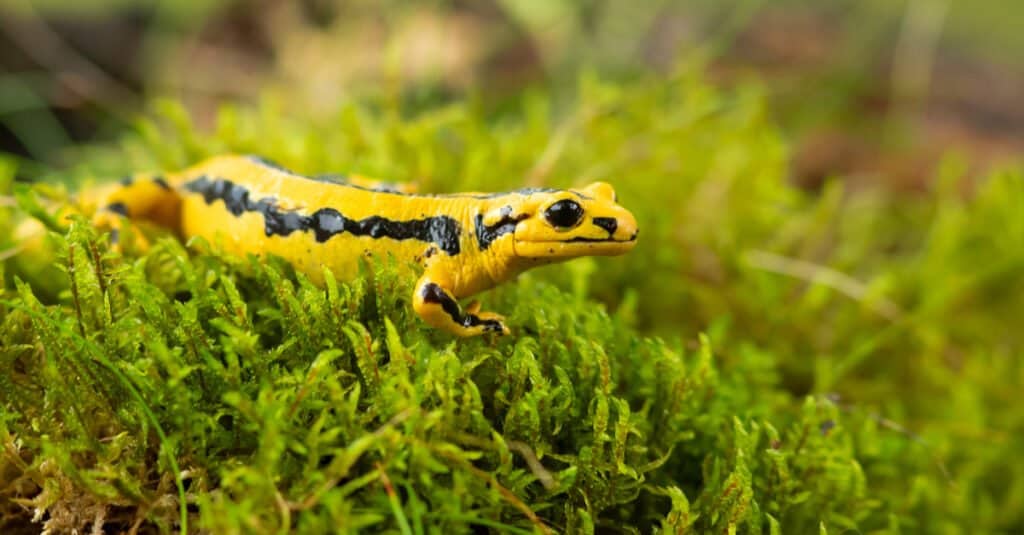While salamanders may look like lizards, they are completely different species. When it comes to a salamander vs lizard, there are many differences that you should know about. Salamanders are amphibians, from the Urodela order of amphibians, while lizards are reptiles from the Squamata order. This is only where their differences begin, as this article will illuminate.
We will discuss some of the key differences between these two animals in detail, including how you can best identify a lizard vs a salamander in the wild. If you’ve never known the differences between these species, you’re in the right place. Let’s dive in and learn more about salamanders and lizards!
Comparing Salamander vs Lizard

| Salamander | Lizard |
|---|---|
| Size 4-8 inches | 1 inch to 10 feet |
| Appearance Smooth, wet skin, no claws on toes, no ear holes; found in a variety of colors | Eyelids and ear holes, ranges in color and pattern, but often found in browns and grays |
| Diet Insects, larvae, spiders, other salamanders | Insects, plant matter, small mammals, large mammals |
| Lifespan 20-50 years, if not longer | 5-30 years, depending on species |
| Habitat Found in or near water exclusively | Depends on species |
| Reproduction 4-100 eggs, depending on species | Depends on species, but usually lays 3-10 eggs per clutch |
The Main Differences Between Salamander vs Lizard

Salamanders look very different from the average lizard, with no ear holes or claws, and their skin appears smooth and wet to the touch, while lizards are covered in rough scales.
©Smarteless/Shutterstock.com
There are many key differences between salamanders vs lizards. Lizards are reptiles while salamanders are amphibians. This makes them inherently different species of animals, despite their similarities in physical appearance. But salamanders also look very different from the average lizard, with no ear holes or claws, and their skin appears smooth and wet to the touch, while lizards are covered in rough scales.
Let’s go into more detail as to the differences between salamanders and lizards. We’ve only just begun!
Salamander vs Lizard: Species
The first and primary difference between a salamander vs lizard is its species classification. Salamanders are considered to be amphibians, while lizards are considered to be reptiles. This is a major difference, although it may not translate into obvious physical differences. Lizards and salamanders have similar body types and sizes, though their skin is inherently different.
For example, salamanders have smooth and wet skin; lizards have rough scales. This is likely due to their species classification, as salamanders spend their entire lives in and around water, while most lizards are entirely terrestrial.

Lizards and salamanders have similar body types and sizes, though their skin is inherently different.
©Fercast/Shutterstock.com
Salamander vs Lizard: Habitat
Another key difference between salamanders vs lizards has to do with their preferred habitats. Salamanders can’t survive without water, while lizards rarely need water in their habitat. Lizards live in arid deserts and terrestrial environments, while some salamanders live their lives entirely in a body of water.
This has to do with the basic species classifications of salamanders vs lizards. Given that salamanders are amphibians, like frogs, they require water in order to survive. However, this is not the same for lizards and many other reptiles.

Salamanders can’t survive without water, while lizards rarely need water in their habitat.
©Milan Zygmunt/Shutterstock.com
Salamander vs Lizard: Toes and Ears
Another key physical difference between salamanders and lizards is their toes. Many lizards are born with claws at the end of each of their toes, while salamanders have no need for claws. Their feet are fully formed, but their toes are often rounded and free of claws. Lizards need claws more than salamanders do, given the amount of time they spend on land.
Another telltale sign that you are dealing with a salamander rather than a lizard is the lack of ears. Lizards are distinct, with ear holes on either side of their heads. Given the aquatic lifestyle that a salamander has, they do not have ear holes in their head. This can help you identify a salamander at first glance.
Salamander vs Lizard: Lifespan
While it depends on the species of salamander vs lizard, the lifespan of salamanders can be very different from the lifespan of most lizards. Many reptiles live long and healthy lives, and lizards are no exception: some lizards live an average of 30 years or longer! However, salamanders may have lizards beat, capable of living over 50 years, with some species living hundreds of years!
While a 200-year-old salamander isn’t necessarily the norm, salamanders tend to live longer lives than lizards do. This is likely due to the species, as certain breeds of salamander don’t live as long as others. Like many animals, both large salamanders and large lizards live longer than their smaller counterparts.

Many lizards are born with claws at the end of each of their toes, while salamanders have no need for claws.
©PINKU HALDER/Shutterstock.com
Salamander vs Lizard: Reproduction
Finally, salamanders differ from lizards in their reproductive habits. Given that salamanders live an aquatic lifestyle rather than a terrestrial life like lizards do, their reproductive life cycle is very different. For example, salamanders attach their small eggs to the underside of rocks and trees in the water, while lizards form a safe nest to lay their eggs in.
The clutch sizes of salamanders and lizards also differ. While it depends on the species, salamanders often lay anywhere from 10-300 eggs; lizards lay an average of 5-30. Salamanders are born into water, which means that their babies develop inherently differently from land-dwelling lizards.
Both salamanders and lizards have certain species that give birth to live young rather than laying eggs. However, these species are few and far between. Given the differences between amphibians and reptiles, you can guess how different it might be to grow up as a salamander rather than a lizard!
The photo featured at the top of this post is © Fercast/Shutterstock.com
Thank you for reading! Have some feedback for us? Contact the AZ Animals editorial team.






